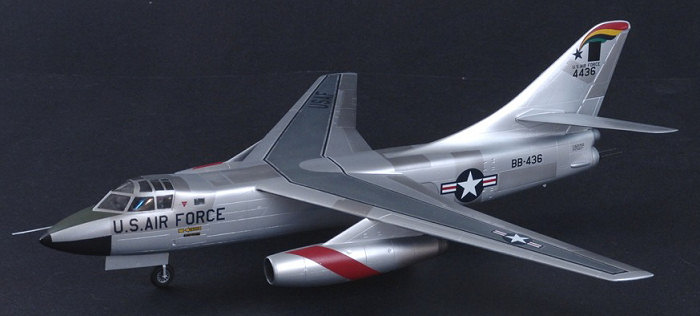
Testors/Italeri 1/72 B-66B
| KIT #: | 677 |
| PRICE: | $19.00 |
| DECALS: | Two options |
| REVIEWER: | Jeff Brundt |
| NOTES: |

| HISTORY |
The Douglas B-66 Destroyer was
originally envisaged as a replacement for the World War 2-era piston-engined
Douglas B-26 Invader. The initial requirement specifically asked for a
reconnaissance vehicle, but the requirement was amended to include tactical
bombing as well. Several companies responded with proposals to meet this
requirement. North American proposed an improved version of its B-45 Tornado
bomber, Boeing proposed an adaptation of its B-47 Stratojet bomber and Martin
proposed a version of the B-51 bomber. Most promising though was Douglas'
proposal of a land-based version of the Navy's XA3D-1 Skywarrior carrier-based
strategic bomber that was then currently under development. However, the XA3D-1
was not scheduled to fly for yet another year and was somewhat of an unknown
quantity. In October of 1951, the USAF Aircraft and Weapons Board announced that
the Douglas design had been approved and the designation B-66 was assigned.
The Air Force originally thought that the B-66 would be more or less an
off-the-shelf copy of the A3D, so there would be no need for prototype XB-66.
Instead, a small initial batch of pre-production aircraft designated RB-66A
(Douglas Model 1326) would be acquired for test and evaluation purposes. There
would be two separate production versions that would be acquired-a
reconnaissance version designated RB-66B and a bomber version designated B-66B.
The reconnaissance version would have the higher priority, and would be equipped
with night photography capability and would carry electronic countermeasures and
reconnaissance equipment. A fast, highly maneuverable tactical reconnaissance
bomber was called for, with a 1000-nautical mile radius. It had to be capable of
carrying at least a 10,000-pound load of atomic weapons, conventional bombs, or
photographic flash bombs. The plane had to be capable of carrying large amounts
of electronic equipment without adversely affecting its normal performance. In
addition, defensive armament had to be carried and electronic countermeasures
equipment was required to deal with enemy radars. Finally, the aircraft had to
be simple and easy to maintain and had to be able to operate from makeshift or
temporary runways. 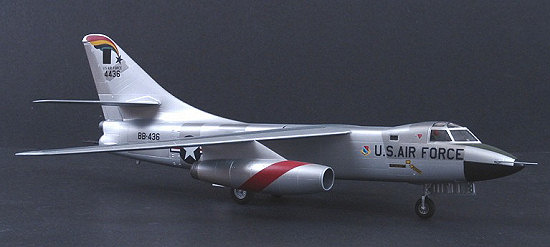
The design of the B-66 was assigned to a Douglas-Long Beach team under the
direction of John C. Buckwalter. The B-66 shared the same basic configuration of
the A3D, with a high-mounted sweptback wing with negative dihedral. The two
engines were mounted in pods attached to under wing pylons. The crew of three
were seated together in a cockpit in the forward part of the nose. The main
landing gear members retracted into wells in the rear fuselage. The first step
in the design was the elimination of the features of the Navy A3D that were
specific to its carrier-based role, such as folding wings, arrester gear, and
catapult harnesses. This was fairly simple to do. An early problem was the fact
that the A3D did not have ejector seats, the crew escaping the aircraft via a
chute in the rear of the cockpit. Since the B-66 would be flying at low
altitudes and at fairly high speeds (the A3D was envisaged as a high-altitude
strategic bomber) upward-firing ejector seats for the three crewmembers had to
be provided. The use of ejector seats in turn required that the cockpit canopy
be extensively revised to accommodate the escape hatches needed for the ejecting
crew. In addition, the cockpit itself had to be extensively revised, with the
pilot sitting centrally forward and the navigator and gunner/reconnaissance
system operator seated immediately aft.
Because of the low altitudes and high speeds that were anticipated, the airframe
structure had to be strengthened. The wing had a revised planform with a reduced
thickness/chord ratio at the root. New ailerons and flaps were fitted. In
addition, the 30-inch radar antenna of the A3D had to be replaced by a 45-inch
antenna for the APS-27 and K-5 bombing and navigation radar. Since the R/B-66
had to be capable of operating from semi-improved or temporary airfields, larger
landing gear tires were required. New emergency air brakes, wing spoilers,
improved lateral controls, and a two percent reduction in the wing angle of
incidence were needed to minimize Dutch roll. The hydraulic system had to be
revised and the fuel system had to be redesigned. The photo-navigator station
had to be relocated, and the aircraft had to be fitted for in-flight refueling.
For the reconnaissance mission, a battery of four cameras was to be mounted in
the center fuselage bay. A new remotely controlled General Electric tail turret
with two 20mm cannon was fitted as the defensive armament. One of the more
significant changes was the need for different engines. The XA3D-1 was to be
powered by a pair of 7000 lbst XJ40-WE-3, with production A3D-1s using the 7500
lbst J40-WE-12. Unfortunately, the J40 turned out to be completely unsuitable
and was the cause of the failure of several combat aircraft projects of the era.
Alternatives had to be considered. Westinghouse offered a new version of the
J40, but this was unsuitable because of its excessive fuel consumption and
because it offered a thrust of only 7250 pounds. The General Electric J73 was
better, but it was ruled to be unsuitable because of its higher cost and its
longer development cycle. Douglas preferred the Pratt and Whitney J57 turbojet
which it had selected for the J40 replacement in the A3D, but this engine was
already committed to other combat aircraft projects that had a higher priority
than the R/B-66 and the Air Force didn't think that the manufacturer could
produce enough engines to meet the demand. This left the Allison J71, which was
built by a division of the General Motors Corporation. It offered a thrust of
9750 pounds. This engine was deemed to be an acceptable alternative, and a
production order specifying the J71 engine was signed in August of 1952.
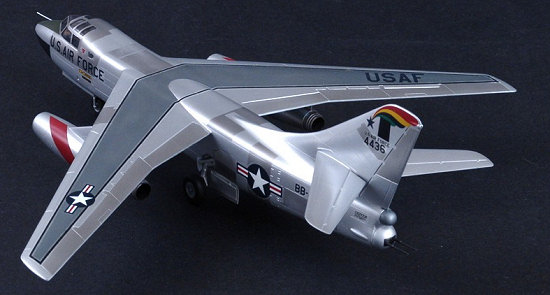 The mockup was inspected at Douglas in late June of 1952. The Air Force was
fairly pleased with what they saw, but they recommended that the landing gear be
redesigned to accept a heavier load of 83,000 pounds. The first of five RB-66A
pre-production aircraft flew at Long Beach on 6/28/54. It was a short hop to
Edwards AFB. In the first few test flights, the aircraft was found not to handle
very well, the landing gear doors did not function properly, and the vision from
the cockpit was poor. The first RB-66A was formally accepted by the USAF in
June, but the plane remained with Douglas for correction of the defects. The
four remaining RB-66As were accepted between August and December of 1954.
Because of the early performance and handling problems that were encountered,
speed and load restrictions had to be imposed which in turn impeded the progress
of flight-testing. The aircraft flight control system proved to be unreliable,
the aircraft's wings vibrated excessively, and the aircraft had the dangerous
property of pitching up unexpectedly. Because of these difficulties as well as
due to schedule slippages, the Air Force began to consider the possibility of
canceling the B-66 project and started looking around for a substitute. The B-66
program was on the verge of cancellation at this point, but it was concluded
that it would be far too expensive at this stage to cancel the program outright
and try to find a substitute. In addition, many of the problems with the RB-66A
had already been identified and progress was being made in correcting them.
Consequently, the Air Force decided that it was better to retain the program,
but the number of planes ordered was cut back by 48. In the meantime, it was
found that a parachute brake would have to be provided, as well as the need for
the addition of an anti-skid device. The cockpit enclosure had to be revised and
the cockpit instruments had to be relocated. Gradually, the problems with the
B-66 were identified and corrected, and the aircraft turned out to be a fairly
reliable design. The control system was reconfigured, the tail turret was
reconfigured, and better engine pylons were installed. The J71-A-9 engines were
replaced by production J71-A-11 engines. The buffeting was reduced to an
acceptable level, and the aircraft's speed was increased to 550 knots. The Air
Force was now sufficiently pleased with the progress on identifying and fixing
the problems that the delivery of production RB-66Bs was expected by the end of
1955. None of the five RB-66As were ever used operationally by the USAF.
The mockup was inspected at Douglas in late June of 1952. The Air Force was
fairly pleased with what they saw, but they recommended that the landing gear be
redesigned to accept a heavier load of 83,000 pounds. The first of five RB-66A
pre-production aircraft flew at Long Beach on 6/28/54. It was a short hop to
Edwards AFB. In the first few test flights, the aircraft was found not to handle
very well, the landing gear doors did not function properly, and the vision from
the cockpit was poor. The first RB-66A was formally accepted by the USAF in
June, but the plane remained with Douglas for correction of the defects. The
four remaining RB-66As were accepted between August and December of 1954.
Because of the early performance and handling problems that were encountered,
speed and load restrictions had to be imposed which in turn impeded the progress
of flight-testing. The aircraft flight control system proved to be unreliable,
the aircraft's wings vibrated excessively, and the aircraft had the dangerous
property of pitching up unexpectedly. Because of these difficulties as well as
due to schedule slippages, the Air Force began to consider the possibility of
canceling the B-66 project and started looking around for a substitute. The B-66
program was on the verge of cancellation at this point, but it was concluded
that it would be far too expensive at this stage to cancel the program outright
and try to find a substitute. In addition, many of the problems with the RB-66A
had already been identified and progress was being made in correcting them.
Consequently, the Air Force decided that it was better to retain the program,
but the number of planes ordered was cut back by 48. In the meantime, it was
found that a parachute brake would have to be provided, as well as the need for
the addition of an anti-skid device. The cockpit enclosure had to be revised and
the cockpit instruments had to be relocated. Gradually, the problems with the
B-66 were identified and corrected, and the aircraft turned out to be a fairly
reliable design. The control system was reconfigured, the tail turret was
reconfigured, and better engine pylons were installed. The J71-A-9 engines were
replaced by production J71-A-11 engines. The buffeting was reduced to an
acceptable level, and the aircraft's speed was increased to 550 knots. The Air
Force was now sufficiently pleased with the progress on identifying and fixing
the problems that the delivery of production RB-66Bs was expected by the end of
1955. None of the five RB-66As were ever used operationally by the USAF.
The Douglas Destroyer was initially manufactured in two separate versions - a
reconnaissance version designated RB-66B (Douglas Model 1329) and a bomber
version designated B-66B (Douglas Model 1327A). They were basically similar in
overall configuration, differing primarily in the equipment carried. The RB-66B
carried flash bombs in its bomb bay for night photography missions and was
equipped with a battery of reconnaissance cameras. The RB-66B could be fitted
with a removable in-flight refueling probe attached to the right side of the
forward fuselage. The first RB-66B flew in March of 1955, and deliveries began
in February 1956. 145 RB-66Bs were built, which made this version numerically
the most important of the Destroyer variants. The RB-66B was basically similar
to the RB-66A pre-production aircraft, differing in being powered by Allison
J71-A-11 turbojets.  Higher-thrust J71-A-13 turbojets were fitted at the factory
to the last 17 RB-66Bs built, and earlier machines were retrofitted with these
engines.
Higher-thrust J71-A-13 turbojets were fitted at the factory
to the last 17 RB-66Bs built, and earlier machines were retrofitted with these
engines.
The first official B-66B flight took place on 1/4/55. The B-66Bs began entering
the Tactical Air Command in March of 1956, which was about a year later than
originally expected. The first recipient was the 17th Light Bombardment Wing,
based at Hurlburt Field in Florida. In September 1956, TAC began to transfer its
B-66Bs to the United States Air Forces in Europe. During the early stages of the
Southeast Asian War, thirteen B-66Bs were adapted to serve in the electronic
countermeasures role as radar jamming aircraft. They were re-designated EB-66B.
All of the bombing equipment was removed and replaced by electronic jamming
equipment. The tail turret was removed, and automatic jamming equipment was
fitted in its place. Numerous antennae protruded from the aircraft, and
chaff-dispensing pods were carried. They were used during the Vietnam War as
electronic warfare aircraft, joining strike aircraft during their missions over
North Vietnam to jam enemy radar installations. They were not "Wild Weasel"
aircraft, since they did not have provisions to attack the radar installations
directly. Two B-66Bs were modified for high-altitude parachute drops of Gemini
and Apollo space capsules. The bomb bay doors were removed and the capsules were
carried semi-externally underneath the fuselage.
| THE KIT |
My kit was the Testors offering from the mid 1980ís. Itís the same kit as the original Italeri issue. I picked it up at a local hobby shop for about $19. I had one years ago but it must have gotten lost or tossed in any number of moves. The kit is nice and has fully engraved panel lines. The plastic is a quasi silver/grey and come in a single poly bag.
| CONSTRUCTION |
The cockpit is done first. The
instrument panel has some detail molded on it as well as the B/N and WSO
stations. Unfortunately they sit too far back to be really visible in the
completed model. The ejection seats are composed of several pieces. I
pre-painted all 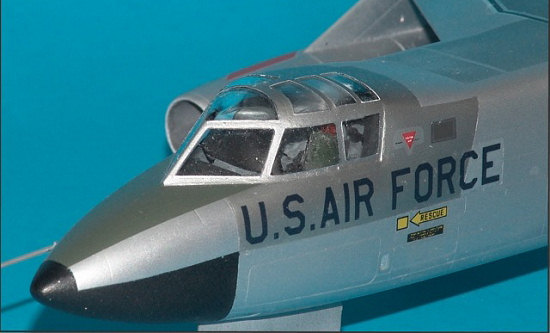 the cockpit parts interior grey followed by painting the IP,
console tops and glareshield black with some dry brushing to pick out the
details. The seats were then detail painted with red arm and head rests. The
WSO windows were glued in place followed by the cockpit and nose wheel well. You
need to add some weight to the nose to prevent it from being a tail sitter. I
used some BBís on each fuse half held in place with thick CA. Once this was done
the fuse halves were joined. Because the only choice of finish for a B-66B is
natural metal you have some seams to clean up. I also glued the canopy in place
and masked it off. I used some putty and Mr. Surfacer and a lot of sanding and
polishing to clean up the seams and to fair the canopy into the fuse. Some of
the panel lines were lost in the process so rescribing was in order.
the cockpit parts interior grey followed by painting the IP,
console tops and glareshield black with some dry brushing to pick out the
details. The seats were then detail painted with red arm and head rests. The
WSO windows were glued in place followed by the cockpit and nose wheel well. You
need to add some weight to the nose to prevent it from being a tail sitter. I
used some BBís on each fuse half held in place with thick CA. Once this was done
the fuse halves were joined. Because the only choice of finish for a B-66B is
natural metal you have some seams to clean up. I also glued the canopy in place
and masked it off. I used some putty and Mr. Surfacer and a lot of sanding and
polishing to clean up the seams and to fair the canopy into the fuse. Some of
the panel lines were lost in the process so rescribing was in order.
The wings and engine pods were assembled, seams filled and sanded. Detail that was lost from sanding on the engine nacelles was rescribed. The horizontals were glued in place and care needs to be taken to assure dihedral and symmetry between the left and right sides. The wings were then glued in place and some filler was required to blend the wings properly with the fuse. Once this was accomplished the engines/pylons were glued in place. The fit of these was very nice and no filler other than the Pro-Weld was needed.
| COLORS & MARKINGS |
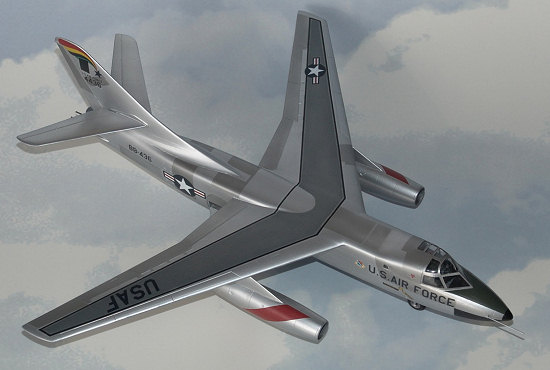 Since this is a NMF airframe plenty
of surface prep is needed to make sure seams and flaws are well hidden. Lots of
time wet sanding, applying Mr. Surfacer and Future and polishing with 2000 to
8000 grit cloth were invested in order to achieve a base for the Floquil bright
silver. Once the silver had dried it was time to mask off panels for the various
of metallic shades. I used a mix of Testors metalizers and Alclad II shades to
achieve the desired effect. I had to be careful in that I applied the Alclad II
colors first followed by the Testors metallizers so as to avoid applying masking
tape over the Testors and thus ruining the finish. The nose radome area was
painted with Tamiya black.
Since this is a NMF airframe plenty
of surface prep is needed to make sure seams and flaws are well hidden. Lots of
time wet sanding, applying Mr. Surfacer and Future and polishing with 2000 to
8000 grit cloth were invested in order to achieve a base for the Floquil bright
silver. Once the silver had dried it was time to mask off panels for the various
of metallic shades. I used a mix of Testors metalizers and Alclad II shades to
achieve the desired effect. I had to be careful in that I applied the Alclad II
colors first followed by the Testors metallizers so as to avoid applying masking
tape over the Testors and thus ruining the finish. The nose radome area was
painted with Tamiya black.
B-66 color schemes were not noted for being colorful. The kit gives you option for two aircraft; The first is an RB-66B of the 42 TRS/10 TRW based at RAF Chelvston in 1960. The second is for the 19 TRS/66 TRW RB-66B based at Spangdalem, Germany in 1959. I chose the first one because of the red diagonal stripe on the engine nacelles and the rainbow comet on the tail. The decals were VERY old and the clear areas of them had a bit of a milk haze to them. I found if I soaked them extra long in the water and used a brush this ďhazeĒ could be removed. Needless to say this resulted in more time than usual to apply all the decals. Microsol helped them to settle nicely. Once decaling was finished I applied a coat of PollyScale clear to seal everything in.
| FINAL CONSTRUCTION |
Now was the time to add all of the fiddly bits; IFR probe, tail guns, landing gear, wheels, doors, etc. After I had these in place the canopy and window masks were removed to reveal the clear parts in all their glory. I applied a light wash in the gear bays to bring out some of the detail there.
| CONCLUSIONS |
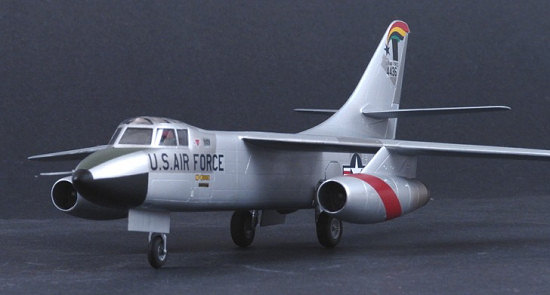 All in all this was a nice build,
despite being a NMF (which I am not a fan of). The kit is going on 30+ years old
but itís still the only game for a bargain priced B-66. The CollectAire kit is
nice for 1/48 scale but itís completed size matches itís price tag. With this
one done Iím tempted to build Italeriís EB-66 in SEAC cammo. That might go a bit
easierÖ..
All in all this was a nice build,
despite being a NMF (which I am not a fan of). The kit is going on 30+ years old
but itís still the only game for a bargain priced B-66. The CollectAire kit is
nice for 1/48 scale but itís completed size matches itís price tag. With this
one done Iím tempted to build Italeriís EB-66 in SEAC cammo. That might go a bit
easierÖ..
| REFERENCES |
Marcelle Size Knaack, Post World War II Bombers, Office of
Air Force History, 1988.
Rene Francillon, McDonnell Douglas Aircraft Since 1920, Naval Institute Press,
1988
Gordon Swanborough & Peter Bowers, United States Military Aircraft Since 1909,
Smithsonian Institution Press, 1989.
Wings: Korea to Vietnam
June 2007
Jeff Brundt If you would like your product reviewed fairly and fairly quickly, please
contact
the editor or see other details in the
Note to
Contributors.